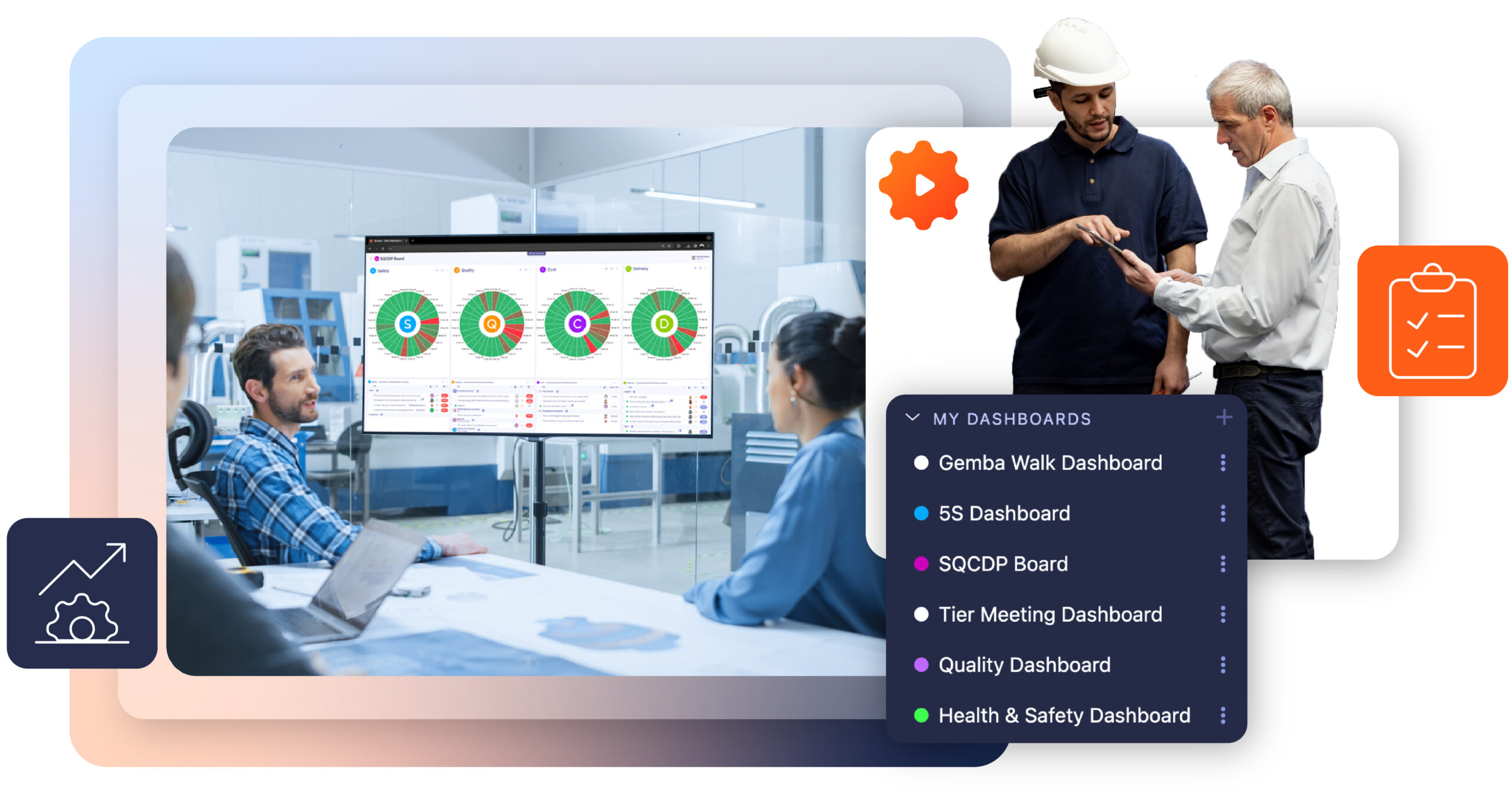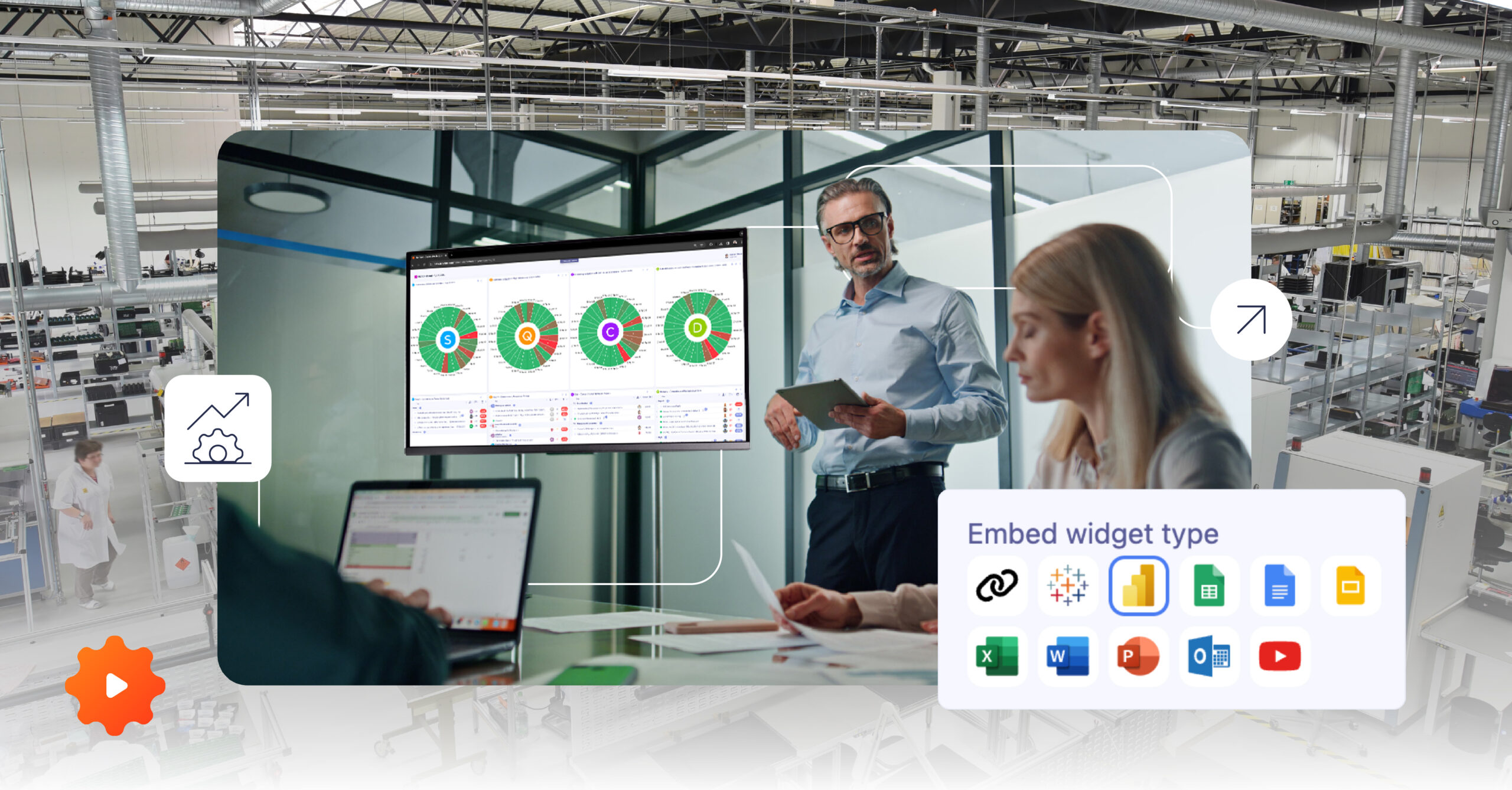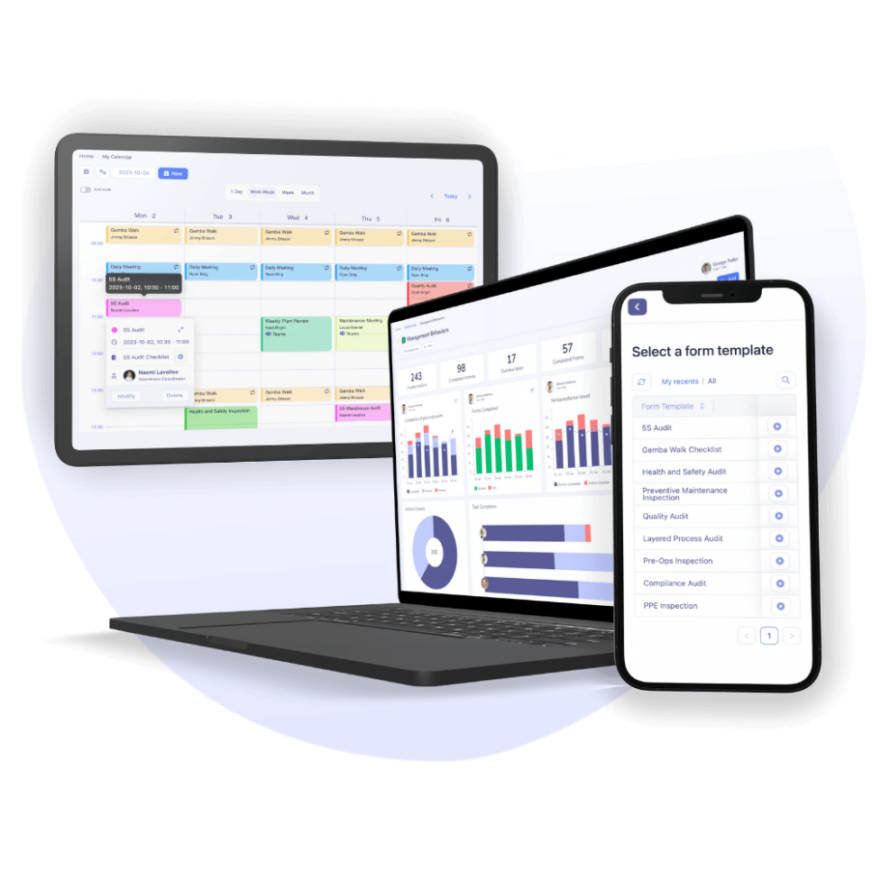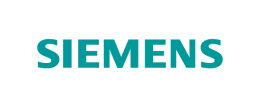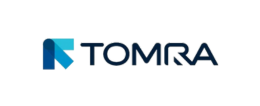Kamishibai Board Explained: Lean Tool, Benefits & Examples

| Audience: | Manufacturing Managers, Healthcare Administrators, Operational Excellence and Lean Management Practitioners, HR Coordinators, Organizational Leaders |
| Last updated: | November 20, 2025 |
| Read time: | 6 min |
- Make daily tasks, audits, and standard work checks visible and trackable.
- Support layered audits, 5S, and continuous improvement on the factory floor.
- Use physical or digital boards to assign tasks, spot issues, and maintain operational control.
What is a Kamishibai board? Lean technique definition
A Kamishibai board is a visual management tool used in Lean manufacturing to track standard work, perform routine audits, and identify problems early. Originally developed within the Toyota Production System, Kamishibai boards have evolved into a key element of visual management across industries. They help manufacturers, supervisors, and frontline teams ensure compliance, enforce quality control, and promote continuous improvement.
What does Kamishibai mean in Japanese?
Kamishibai (kah-mee-she-bye) means “paper drama” in Japanese, referring to a traditional storytelling method using illustrated cards. This idea was adapted to Lean practices by transforming task tracking into a visual narrative, making operations on the factory floor more structured and transparent.

Kamishibai organization in Lean manufacturing
This approach strengthens audit culture while making compliance more visible and consistent across teams. Kamishibai boards support layered audits, empower employee accountability, and simplify compliance monitoring without complex applications.
Unlike Kanban boards, which manage workflow, Kamishibai boards confirm that critical steps are completed, making them ideal for:
- Daily standard work confirmation
- Layered process audits
- Leader Standard Work (LSW)
- Safety, quality control, and compliance tracking
Manufacturers using this system benefit from increased clarity and fewer disruptions. With careful planning and consistent routines, this approach reinforces operational excellence in environments where even minor oversights can become costly. It is an important part of many companies’ Lean transformations.
Why use a Kamishibai board?
The disciplined use of Kamishibai boards allows organizations and companies to:
- Make expectations visible
- Confirm task execution
- Identify gaps early
- Assign clear accountability
At a glance, teams can see:
- What needs to be done
- Who is responsible
- What’s completed or pending
- Where corrective actions are needed
These boards are flexible enough to support daily routines, weekly checks, and even quarterly audits depending on the cadence required. The approach works especially well when integrated with other Lean strategies and supports cross-functional teams, managers, and workers alike.
Industry leaders leverage Tervene to gain visibility

What should Kamishibai cards include? Needed supplies
A Kamishibai board should be simple, clear, and easy to update. Key components include:
- Kamishibai cards: One task per card (e.g., “Check PPE station,” “Inspect emergency exits”)
- Hooks or slots: To visually separate tasks that are “To Do” and “Done”
- Color indicators: Green (complete), Red (issue or incomplete), Yellow (in progress)
- Assignment and frequency: Owner name or role, and frequency (daily, weekly, monthly)
Popular task categories include:
- Safety inspections
- 5S audits
- Equipment checks
- Gemba walks
- Quality control verifications
Color coding helps teams immediately spot issues and incomplete tasks. Kamishibai cards benefit from consistent formatting and clear ownership.
How to make a Kamishibai board (examples, templates & setup)
You don’t need advanced systems to create a Kamishibai board. A basic setup can include:
- A whiteboard, corkboard, or pegboard
- Printed or laminated task cards
- Color-coded tags or magnets
- Columns labeled by rotation or day
To maintain consistency:
- Use a template for Kamishibai cards
- Include only one task per card
- Assign responsibility with initials or tags
- Review and rotate tasks regularly
This approach makes setup accessible to teams of all sizes, from small shops to multi-site manufacturers. Many companies adopt Kamishibai boards as part of broader Lean applications to improve structure and communication.
Gain clear visibility and track KPIs with Tervene’s tools
What tasks can you track with Kamishibai boards?
Kamishibai boards are suited to routine and recurring tasks that benefit from visibility. Examples include:
- Daily: Fire extinguisher checks, workstation cleanliness, PPE verification
- Weekly: 5S audits, quality logs, Gemba walks
- Monthly: Training reviews, compliance documents, equipment calibration
Kamishibai boards are an important part of daily routines for manufacturers seeking high reliability and consistency. Tip: don’t overload the board. Focus on high-impact tasks to prevent audit fatigue and improve long-term adoption.
Physical vs. digital Kamishibai boards
Physical boards are great for smaller teams or localized audits. But digital Kamishibai boards offer greater flexibility and control—especially for multi-site companies.
| Feature | Physical Kamishibai | Digital Kamishibai |
|---|---|---|
| Task visibility | Manual (cards) | Real-time dashboard |
| Reminders & alerts | Manual | Automated |
| Data tracking | Paper or Excel | Built-in analytics |
| Accessibility | On-site only | Mobile & remote |
| Integration with DMS | Not connected | Seamless |
| Audit follow-through | Manual | Auto-tracked |
Digital boards also:
- Trigger alerts and escalation for missed tasks
- Collect audit history for traceability
- Support data collection across sites
- Display results through interactive dashboards
- Improve integration with ERP, MES, and quality systems
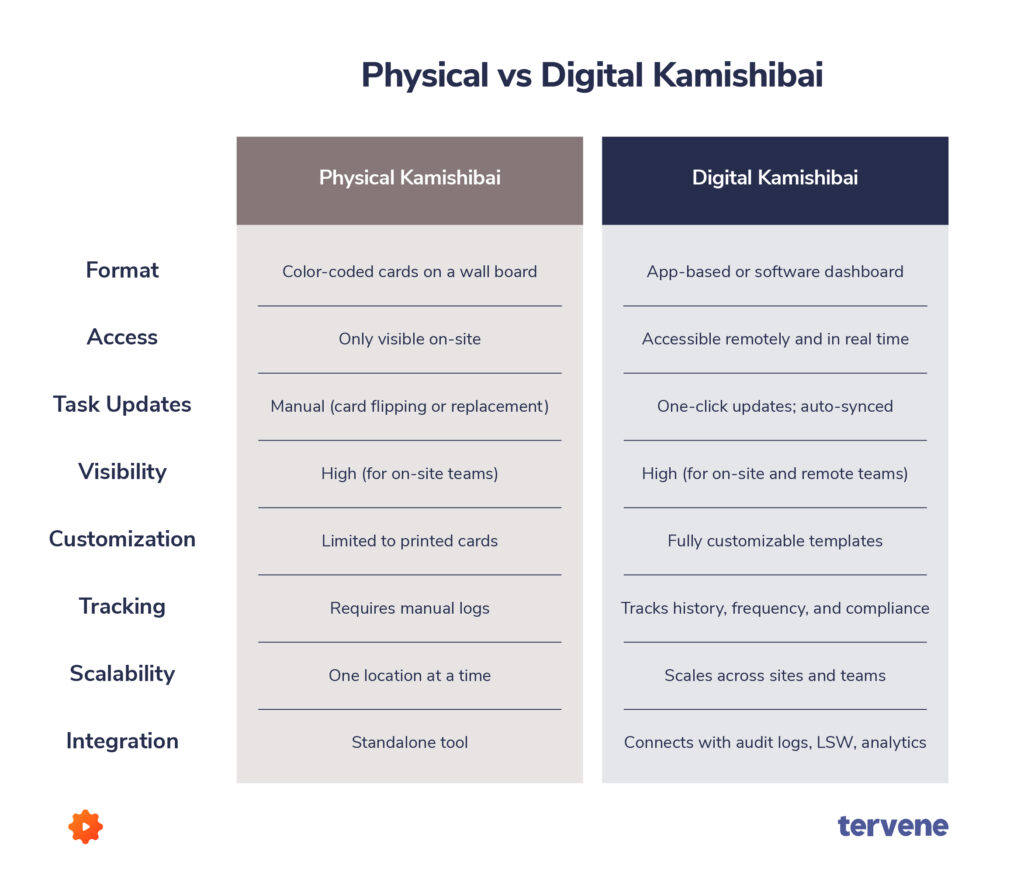
Kamishibai vs other visual management tools: 5S, Kanban, SQCDP, and more
Kamishibai boards are a natural complement to many other visual management tools, such as 5S (Sort, Set in order, Shine, Standardize, Sustain). They help:
- Confirm 5S checks are performed
- Standardize audit frequencies
- Involve frontline workers in cleanliness and order maintenance
For example, “Check breakroom sink cleanliness” or “Inspect tool rack labeling” are perfect daily 5S card tasks. Kamishibai cards bring visibility and discipline into areas that are often overlooked, reinforcing kaizen culture and accountability on the factory floor.
Here’s a table to compare Kamishibai to other visual management tools:
| Tool | Focus | Best for |
|---|---|---|
| Kamishibai | Standard work, layered audits | Routine task tracking, compliance |
| Kanban | Work-in-progress, flow | Production scheduling, project tasks |
| SQCDP | KPIs (Safety, Quality, etc.) | Performance monitoring |
| Andon | Real-time issue alerts | Escalation and operator feedback |
| Daily Mgmt | Team coordination | Meeting facilitation, task tracking |
Kamishibai stands out as a unique approach among visual management tools. It is an important part of confirming standards, while others focus on flow, real-time issues, or team communication. When applied correctly, Kamishibai enables companies to unify their Lean strategies with simple, effective execution.
How to get started
- Choose focus areas: Start with 2–3 priorities (e.g., safety, compliance, 5S)
- List clear tasks: Use short, specific language (avoid vagueness)
- Assign ownership: Use initials, team roles, or name tags
- Create a rotation: Label tasks by frequency (daily, weekly, etc.)
- Review routinely: Use during huddles or Gemba walks to maintain momentum
Companies that succeed with Kamishibai usually start small and scale gradually. Aligning the tool with other Lean strategies helps build habits and trust among teams.

Explore 10 Visual Management Must-Haves [eBook]
Kamishibai board system for Lean audits & continuous improvement
Kamishibai boards are more than task trackers—they’re part of a larger Lean system supporting audits, problem-solving, and proactive improvement. They:
- Reinforce daily standard work
- Enable root cause analysis when deviations appear
- Support data collection and trends
- Encourage employee participation and ownership
They also promote a structured cadence of accountability that strengthens team culture over time. Used effectively, Kamishibai boards contribute to operational excellence while aligning with company-wide improvement strategies.
Final thoughts: Is Kamishibai right for you?
Kamishibai boards offer a low-tech, high-impact solution for operational control. They provide structure, visibility, and shared accountability. Whether you’re a small team or a global manufacturer, this tool helps companies improve execution on the factory floor.
Looking for a turnkey solution? Tervene’s digital visual management tools integrates seamlessly with your existing daily management system, helping you digitize layered audits, drive operational control, and empower your frontline teams.
Digitize your dashboards with Tervene and gain better visibility into your operations and KPIs
- Use mobile and digital boards to share performance instantly
- Build custom dashboards to track KPIs, corrective, and preventive actions
- Keep teams aligned with standardized displays and updates
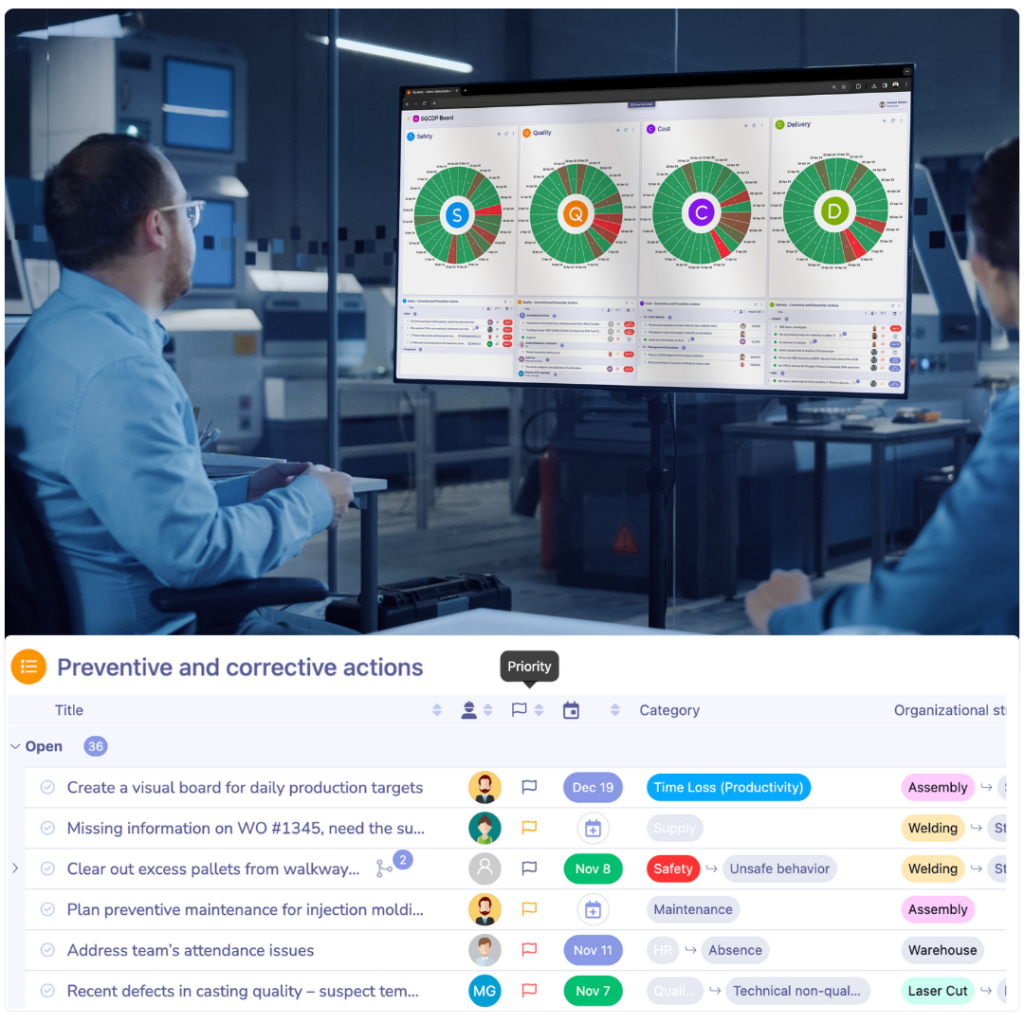
FAQ: Kamishibai boards
A Kamishibai board is a visual management tool used in Lean manufacturing to track routine tasks, confirm standard work, and support layered audits. It typically uses cards to show whether checks have been completed, making compliance and accountability visible at a glance.
Kamishibai boards help manufacturers maintain daily discipline by assigning and rotating audit tasks across teams. They’re often used for 5S audits, safety checks, equipment inspections, and standard work confirmations. They’re especially effective when combined with Gemba walks and daily huddles.
Kanban boards manage work in progress and optimize flow, especially in production or software teams. Kamishibai boards, by contrast, are designed to confirm that routine tasks and audits are being performed consistently. They focus on compliance, not flow.
Each card should have one specific task, the person or role responsible, and the task frequency (daily, weekly, etc.). Cards are color-coded (e.g., green for complete, red for incomplete or flagged) to signal task status visually.
Yes. Digital Kamishibai boards allow teams to assign tasks, track progress, trigger alerts, and store audit history. They’re especially useful for multi-site operations and integrate well with tools like ERP, MES, and DMS platforms.
Tasks that are routine, repetitive, and require consistent execution work best. Examples include safety checks, 5S audits, quality control inspections, documentation reviews, and equipment maintenance confirmations.
By making routine tasks and gaps visible, Kamishibai boards help teams catch issues early, analyze root causes, and take corrective action. This visibility builds a culture of accountability and supports Kaizen efforts across the organization.

